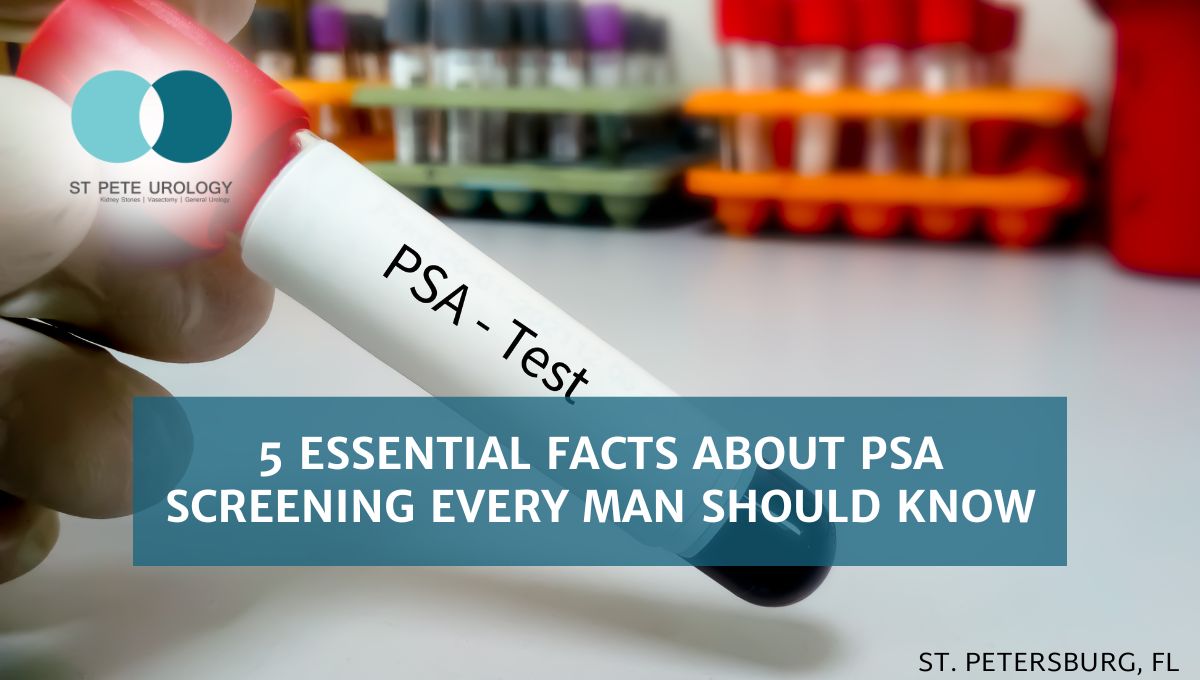3 Key Takeaways:
- Start screening discussions at the right age: Men at average risk should discuss PSA screening at 55, while high-risk individuals—including African American men and those with family history—should begin conversations as early as 40.
- PSA numbers are age-dependent: What’s normal changes with age; levels above 2.5 ng/mL for men under 60 and above 4.0 ng/mL for men in their 60s warrant further investigation, while velocity matters as much as absolute values.
- Screening involves tradeoffs: While PSA testing can detect cancer early when it’s most treatable, it also carries risks of false positives, unnecessary biopsies, and overdiagnosis of slow-growing cancers that may never threaten health.
 Prostate-specific antigen (PSA) testing remains one of the most debated yet valuable tools in men’s health. In 2025, approximately 313,780 new prostate cancer cases and 35,770 prostate cancer deaths are expected in the United States, making early detection critical. The question isn’t whether PSA screening matters—it’s understanding who needs it, when to start, and what those numbers actually tell you about your health.
Prostate-specific antigen (PSA) testing remains one of the most debated yet valuable tools in men’s health. In 2025, approximately 313,780 new prostate cancer cases and 35,770 prostate cancer deaths are expected in the United States, making early detection critical. The question isn’t whether PSA screening matters—it’s understanding who needs it, when to start, and what those numbers actually tell you about your health.
Who Should Get PSA Screening
PSA screening isn’t one-size-fits-all. Current guidelines emphasize shared decision-making between patients and their healthcare providers, with recommendations varying based on age and risk factors.
The American Urological Association recommends that men aged 55 to 69 years discuss the benefits and harms of PSA screening with their doctors. For average-risk men, this conversation typically begins at 55. However, high-risk individuals should consider earlier screening.
Men who fall into high-risk categories include:
- African American men, who have a higher risk of developing aggressive prostate cancer
- Men with a first-degree relative (father or brother) who had prostate cancer
- Men with multiple family members affected by prostate or other cancers
- Carriers of BRCA1, BRCA2, or other genetic mutations linked to cancer
For high-risk men, PSA screening conversations should begin between ages 40 and 54. At St. Pete Urology, our board-certified urologists work with patients to assess individual risk factors and create personalized screening plans.
Understanding PSA Levels and What They Mean
PSA levels measure the amount of prostate-specific antigen in your blood, reported in nanograms per milliliter (ng/mL). Understanding what constitutes “normal” requires considering your age, as PSA naturally increases as men get older.
For men in their 40s and 50s, a PSA score greater than 2.5 ng/mL is considered abnormal, with the median PSA for this age range between 0.6 and 0.7 ng/mL. For men in their 60s, levels above 4.0 ng/mL warrant further investigation.
Here’s what PSA levels typically indicate:
Below 2.5 ng/mL: Generally considered low risk, though not a guarantee of absence of cancer
2.5 to 4.0 ng/mL: Within normal range for most men, particularly those over 50
4.0 to 10.0 ng/mL: Borderline range that may indicate increased risk and often prompts additional testing
Above 10.0 ng/mL: Significantly elevated and requires immediate medical attention
PSA levels above 10 ng/mL indicate you have a greater than 50% chance of having prostate cancer. However, elevated PSA doesn’t automatically mean cancer—benign prostatic hyperplasia (BPH), prostatitis, and even recent physical activity can temporarily raise levels.
PSA velocity—how quickly your levels rise over time—matters as much as the absolute number. A PSA score rising more than 0.35 ng/mL in a single year may warrant further testing, even if the total number remains in the “normal” range.
If you’re experiencing symptoms like frequent urination or difficulty emptying your bladder, your urologist will consider both your PSA level and clinical presentation when recommending next steps.
When to Start and How Often to Test
Timing matters with PSA screening. A single baseline PSA level is suggested for all men aged 40 to 45, with annual testing reasonable in higher-risk men starting at 45.
For men whose PSA level is less than 2.5 ng/mL, retesting may only be needed every 2 years. Those with PSA levels of 2.5 ng/mL or higher should consider yearly screening. Your physician will adjust this frequency based on your individual results and risk profile.
Routine screening should be discontinued in men with a life expectancy of 10 years or less based on comorbidities or by the age of 75. This doesn’t mean older men can’t be screened—rather, the decision becomes more nuanced, weighing potential benefits against the risks of overdiagnosis and treatment side effects.
The concept of shared decision-making is central to modern PSA screening guidelines. Before any PSA test, men should understand both the potential benefits of early cancer detection and the risks of false positives, unnecessary biopsies, and identifying slow-growing cancers that may never cause symptoms.
Benefits and Limitations of PSA Testing
PSA screening has revolutionized prostate cancer detection, enabling doctors to identify disease years before symptoms appear. Screening programs in men aged 55 to 69 years may prevent approximately 1.3 deaths from prostate cancer over approximately 13 years per 1,000 men screened.
The benefits include:
- Early Detection: Identifying cancer when it’s most treatable
- Monitoring: Tracking changes over time in men on active surveillance
- Risk Assessment: Combined with other tests and digital rectal exams for comprehensive evaluation
- Treatment Planning: Guiding decisions about minimally invasive surgical options
However, PSA testing has limitations. About 6-7% of men have a false-positive PSA test on any given screening round, and only about 25% of men who have a biopsy due to an elevated PSA level are found to have prostate cancer.
False positives can lead to anxiety and unnecessary procedures. Prostate biopsies carry risks including infection, pain, and bleeding. Approximately 1% of prostate biopsies result in complications requiring hospitalization.
Perhaps the most significant concern is overdiagnosis—detecting slow-growing cancers that would never cause symptoms or shorten life expectancy. Many low-grade prostate cancers grow so slowly that men die with them rather than from them, particularly in older age groups.
The National Cancer Institute and American Cancer Society both emphasize informed decision-making, ensuring patients understand these tradeoffs before proceeding with screening.
Taking Control of Your Prostate Health
PSA screening represents a powerful tool in men’s health when used appropriately. The key is understanding your personal risk factors, starting conversations with your doctor at the right age, and interpreting results within the broader context of your overall health.
Bottom line: Most men should discuss PSA screening starting at 55, while high-risk men should begin these conversations as early as 40. Your PSA number matters, but it’s just one piece of the puzzle—trends over time, age-adjusted ranges, and clinical symptoms all inform the complete picture.
At St. Pete Urology, our team of board-certified urologists—Dr. Reid Graves, Dr. Nicholas Laryngakis, Dr. Adam Oppenheim, and Dr. Ankur Shah—specialize in comprehensive prostate cancer screening and treatment. We believe in partnering with each patient to make informed decisions about screening, diagnosis, and treatment options tailored to your unique situation.
Don’t wait for symptoms to appear. If you’re approaching 55, or if you have risk factors that suggest earlier screening, contact St. Pete Urology at (727) 478-1172 to schedule a consultation. Early detection saves lives, and we’re here to guide you through every step of protecting your prostate health.
References:
- American Cancer Society. (2025). American Cancer Society recommendations for prostate cancer early detection. Retrieved from https://www.cancer.org/cancer/types/prostate-cancer/detection-diagnosis-staging/acs-recommendations.html
- National Cancer Institute. (2025). Prostate cancer screening (PDQ®)–health professional version. Retrieved from https://www.cancer.gov/types/prostate/hp/prostate-screening-pdq
- Pavlovich, C. (2025, May 27). Prostate cancer: Age-specific screening guidelines. Johns Hopkins Medicine. Retrieved from https://www.hopkinsmedicine.org/health/conditions-and-diseases/prostate-cancer/prostate-cancer-age-specific-screening-guidelines
- U.S. Preventive Services Task Force. (2018). Screening for prostate cancer: U.S. Preventive Services Task Force recommendation statement. Retrieved from https://www.uspreventiveservicestaskforce.org/uspstf/recommendation/prostate-cancer-screening





